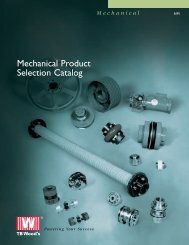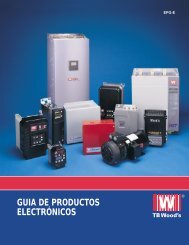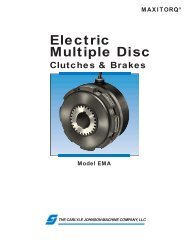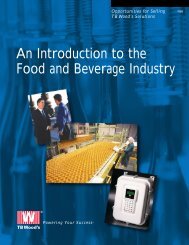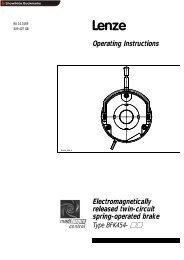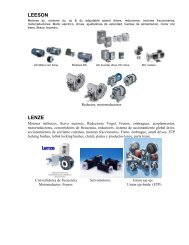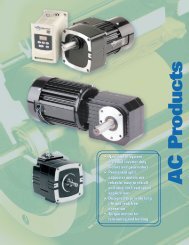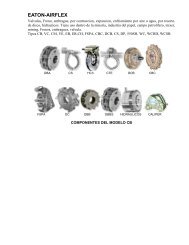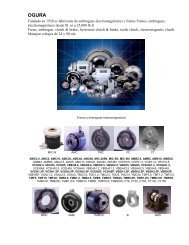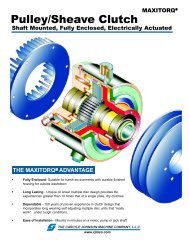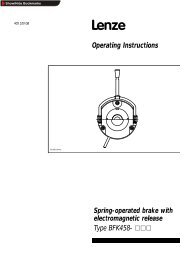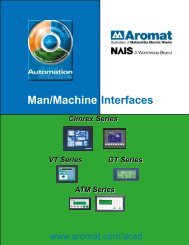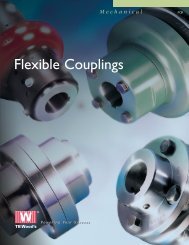Wood’s@Work
TB Wood's - Southern Power
TB Wood's - Southern Power
You also want an ePaper? Increase the reach of your titles
YUMPU automatically turns print PDFs into web optimized ePapers that Google loves.
W i n t e r 2 0 0 3 • V o l u m e 6<br />
<strong>Wood’s@Work</strong><br />
®<br />
TB Wood’s —<br />
A Sure Bet in Las Vegas<br />
E-trAC,WFCHT & WF2<br />
Something to Crow About<br />
TBWOODS.COM<br />
Changing to Meet Your Needs<br />
Powering Your Success
<strong>Wood’s@Work</strong><br />
®<br />
All In a Day’s Work<br />
Michael Hurt<br />
President<br />
New Products For<br />
More Wood’s @ Work<br />
Success In 2003<br />
In 2002 we introduced new products to<br />
offer more opportunities to put “Wood’s<br />
@ Work”. We added to our product portfolio<br />
a broad line of gearmotor and gear<br />
reducer products, and a new line of E-<br />
traAC ® EF1 Microdrives. These new products<br />
combined with our existing AC drive<br />
products and broad mechanical product<br />
offerings of belted drives and couplings<br />
should offer many more opportunities to<br />
put “<strong>Wood’s@Work</strong>.”<br />
As we leave 2002 and move into 2003, I think it’s<br />
worth reflecting on the past 12 months. From a<br />
revenue growth perspective, 2002 was a disappointing<br />
year for TB Wood’s. We continued to see<br />
soft demand due to the sluggish industrial economy.<br />
However, we remained committed to our<br />
business strategy consisting of these key elements:<br />
1. Aggressively develop new and differentiated<br />
products and services<br />
2. Serving our selective distribution partners with<br />
excellence<br />
3. Drive for continuous cost reductions and efficiency<br />
improvements<br />
4. Make accretive strategic acquisitions<br />
Continuing our tradition of bringing you new and<br />
differentiated products, we remained committed to<br />
Our drive<br />
churns through<br />
a blizzard of<br />
gizzards<br />
Chickens are peculiar birds. In order to<br />
better digest their food, they eat small pebbles.These<br />
pebbles wind up in the chicken’s<br />
gizzard. Grinding up the pebbles with the<br />
gizzards for use in animal food can dull the<br />
blades of the gizzard harvester, but more<br />
importantly, in the manufacture of humangrade<br />
food, the ground pebbles are not<br />
acceptable by either the food processor or<br />
the FDA.<br />
“TB Wood’s chicken and poultry manufacturing<br />
clients use the NSF Series ® WF2 controller<br />
to sense the load, pause when the<br />
load indicates pebbles, then change direction<br />
so they can be<br />
removed,” explains<br />
Curtis Litten,<br />
applications<br />
manager for TB<br />
Wood’s. “After the<br />
pause to remove the objects, the program<br />
restarts and resets to continue the process.”<br />
The key to the TB Wood’s gizzard harvester<br />
solution is a standard program sequencer<br />
feature in WF2 software.<br />
A Programmable Logic Control (PLC) miniprogram<br />
in the WF2 software allows the<br />
operator to set a sequence of timed operational<br />
steps.<br />
For example, in step one in the gizzard harvester<br />
program, the drive is set at a desired<br />
production speed. If a stone or pebble is<br />
sensed, the drive shifts to the second step in<br />
the sequence and stops.<br />
In the third step, Litten says, the drive is<br />
reversed so the operator can spot the foreign<br />
matter and remove it.<br />
Finally, after pausing the assigned length of<br />
time, the program cycles to the beginning<br />
of the sequence and restarts the production<br />
process.The sequence program runs continuously<br />
throughout the production day.<br />
“Because TB Wood’s builds the sequencing<br />
program right into the drive it doesn’t need<br />
to be added on as an extra piece of equipment.This<br />
is a major difference between the<br />
Wood’s design and competitive products. It<br />
means we can save our clients 15% to 20%<br />
over the cost of competitive systems,”<br />
Litten states.<br />
As the saying goes, that ain’t chicken feed.<br />
Continued on inside back cover.<br />
W i n t e r 2 0 0 3 • V o l u m e 6
Power Tools<br />
Adding to your<br />
sales momentum<br />
At TB Wood’s, we’re doing our part to educate<br />
your customers about our well-engineered<br />
products, worldwide reputation and<br />
well respected brand. Our 2003 advertising<br />
schedule is designed to support your own<br />
advertising efforts in both the electrical and<br />
mechanical markets. Throughout the next<br />
year, we’ll be advertising the TB Wood’s<br />
brand and family of products in a targeted<br />
group of electrical and mechanical engineering<br />
trade publications.<br />
To help customers find you, each ad will<br />
contain our Web site address. On our site,<br />
prospects can locate the TB Wood’s distributor<br />
closest to them.<br />
Look for our ads in these top tier industry<br />
publications: New Equipment Design,<br />
Motion System Design, Food Processing,<br />
Machine Design, and Industrial Distribution.<br />
The TB Wood’s Web site<br />
is being revised and new<br />
features will begin<br />
appearing early in 2003.<br />
TBWOODS.COM changing<br />
to meet your needs<br />
Our 2003 ads will be running in these trade<br />
publications to increase awareness of TB Wood's<br />
products and to direct customers to you.<br />
After extensive review of TBWOODS.COM,<br />
the company’s Web Advisory Committee<br />
(WAC) recommended a major overhaul of<br />
the look, feel and functionality of the Web<br />
site.<br />
“The redesigned TBWOODS.COM will be<br />
a huge improvement over the old site,” said<br />
Tracey Schroder, marketing services manager.<br />
“WAC focused on improving the site for our<br />
distributors. We took our time and carefully<br />
reviewed not only how the site looked, but<br />
how it functioned and, most importantly,<br />
how distributors would use this valuable<br />
tool.”<br />
Many of WAC’s recommendations came<br />
from a focus group that included Wood’s distributors,<br />
outside consultants and representatives<br />
from Wood’s sales, marketing, engineering,<br />
production and information services<br />
departments. They carefully reviewed the<br />
site, screen-by-screen.<br />
Based on what was learned in the focus<br />
group, the site will be redesigned with new<br />
enhancements starting to appear in the first<br />
quarter. Look for the most requested<br />
upgrade – <strong>Wood’s@Work</strong> ® application stories<br />
that will be archived in a password protected<br />
distributor-only area.<br />
W i n t e r 2 0 0 3 • V o l u m e 6
POWER<br />
SOLUTIONS<br />
GoodNews<br />
Patience, Professionalism<br />
Lead to The Big Sale<br />
by Arnie Colbert<br />
To make a big sale, I believe you have to<br />
know the customer’s product and<br />
process as well as you know your own<br />
product. You have to look at how they’re<br />
doing things now and figure out how<br />
Wood’s products can make business<br />
easier and better for them. You need<br />
to be able to offer a Wood’s solution to<br />
their problems and to their customers’<br />
problems.<br />
That’s how we landed the Goulds Pump<br />
account in Seneca Falls, NY. We worked<br />
with them for five years, calling on them<br />
about every two weeks before I finally<br />
sold the account. Closing that sale<br />
helped me win the TB Wood’s Electronic<br />
Charge Award in 2002. That honor goes<br />
to the person who has done the most<br />
each year to promote the electronics<br />
portion of Wood’s business. I’m really<br />
proud to have received it this year.<br />
I’m proof, I guess, that some really worthwhile<br />
sales in this industry can take time.<br />
I’ve been with Wood’s for seven years,<br />
working as an automation sales engineer<br />
until I moved to the OEM division as an<br />
account manager. During my sales<br />
career, I’ve learned good customer relationships<br />
are built on simple but important<br />
things: being on time, being professional,<br />
being responsive to customer<br />
needs and problems, and listening to customers<br />
to learn what they need. If you<br />
do that, and persistently call on them,<br />
you can learn enough to offer valuable<br />
solutions to them. Then you’ll be there<br />
with the answer when the contract<br />
comes up.<br />
Arnie Colbert is OAM for TB Wood’s North Central and<br />
Northeast sales regions.<br />
It’s a sure bet: Wood’s<br />
solution adds bottom<br />
line energy savings<br />
Air handlers in Las Vegas casinos never get a<br />
day off. “This city runs on gambling,” says<br />
Larry Carruthers, sales rep for Aztec<br />
Industrial Bearing and Supply, a TB Wood’s<br />
distributor. “If you have a high roller playing<br />
blackjack and the air conditioning shuts<br />
down, a casino can lose untold dollars.These<br />
systems have to work 24/7, year after year.”<br />
Last summer Aztec got the chance to<br />
redesign and replace 80 primary air handlers<br />
at the Rio All-Suite Hotel and Casino and<br />
the Rio was the big winner.The TB Wood’s<br />
E-Flow adjustable speed drive packages lowered<br />
the casino’s energy costs with a<br />
dependable, better engineered approach.<br />
This playground known as Las Vegas, Nevada<br />
The TB Wood’s E-Flow<br />
System lowered the<br />
casino’s energy costs with<br />
a dependable,<br />
better engineered<br />
new approach.<br />
is the fastest growing city in the United<br />
States. Along with this growth has come a<br />
substantial increase in electrical energy useage.<br />
The hotel and casino industry has been<br />
under the gun to find creative ways to save<br />
energy. Air handlers are the primary consumers<br />
of electrical energy in any hotel and<br />
casino. Aztec Industrial Bearing, saw an<br />
opportunity to help with this cause.<br />
The TB Woods’ solution began with Larry<br />
Carruthers. He understood the Rio’s needs<br />
and knew the new air handler design had<br />
to be:<br />
Reliable: Each component had to be well-<br />
engineered and durable enough to stand up<br />
to unrelenting use.<br />
Energy efficient: The desert environment<br />
is extreme with summer temperatures that<br />
can hover over 100 degrees for days. Since<br />
the cost per kilowatt-hour in Las Vegas is<br />
high, each handler needs to provide the maximum<br />
cooling for the least amount of energy.<br />
Low maintenance: Wear and tear on individual<br />
components in the system needed to<br />
be minimized.The need to continually replace<br />
parts or components could eat up any energy<br />
savings.<br />
Air flow before TB Wood’s<br />
“The Rio air handlers were using discharge<br />
dampers to control the air flow,” Rusty<br />
Heller,TB Wood’s Western Regional Manager,<br />
remembers.The old handler used a 40HP<br />
1750-RPM motor with a V-belt to drive a<br />
centrifugal fan.That energy-eating fan ran at a<br />
constant speed 24-hours a day. When more<br />
airflow was needed, a signal from the transducer<br />
opened the discharge dampers allowing<br />
additional air flow.<br />
“This was a very inefficient system,” Heller<br />
explains. “The fan<br />
was a constant<br />
energy drain and<br />
maintaining the<br />
fan and the discharge<br />
dampers<br />
was a maintenance<br />
headache.”<br />
Rusty Heller<br />
The TB Wood’s solution<br />
Aztec solved the Rio’s problem by installing a<br />
TB Wood’s E-Flow adjustable speed drive<br />
package that matched the speed of the fan<br />
W i n t e r 2 0 0 3 • V o l u m e 6
motor to the demand for the air flow.The<br />
discharge dampers are left wide open all the<br />
time, saving wear and tear on these mechanical<br />
devices. Using the TB Wood’s E-Flow<br />
design, a transducer that measures pressure<br />
in the air ducts, converts this variable to a<br />
0 – 10V reference signal.This reference signal<br />
is fed to the E-Flow variable frequency drive<br />
which matches the speed of the motor to<br />
the required air flow.<br />
The TB Wood’s designed system also included<br />
synchronous-belted drives in place of the<br />
old V-belt drives.The synchronous belt transfers<br />
power more efficiently saving additional<br />
energy, making a maintenance-free solution<br />
that runs at 98% efficiency all the time. A<br />
typical V-belt drive runs at 93% at best and<br />
this is rarely the case.<br />
Pay out<br />
“How much energy savings the casino will<br />
realize from the new air handling system<br />
depends, of course, on a lot of factors,”<br />
Carruthers cautions. “It’s affected by the outside<br />
temperature, the humidity and how<br />
many people are in the building, for instance.”<br />
Still, he conservatively estimates that modifying<br />
80 of the 123 air handlers with TB<br />
Wood’s products could easily cut the Rio’s<br />
air handling energy cost by 25% the first year.<br />
(The remaining handlers are fractional HP<br />
units and were not part of the redesigned<br />
system.)<br />
The TB Wood’s difference<br />
The experts at TB Wood’s worked in partnership<br />
with Aztec and Carruthers to engineer<br />
and customize the air handler systems<br />
to the Rio’s specific needs.<br />
“Rusty Heller (TB Wood’s western regional<br />
manager) was very helpful in designing the<br />
electronics for each air handler,” Carruthers<br />
says. Using TB Wood’s computer programs,<br />
Carruthers was able to choose the appropriate<br />
synchronous drive for each handler.<br />
Heller also directed the TB Wood’s factory<br />
to pack all the components for each Rio air<br />
handler as a unit. Instead of 400 individual<br />
parts arriving at the Rio to be sorted out,<br />
the components for each air handler arrived<br />
in one box. Installation went very smoothly,<br />
Carruthers says.<br />
“TB Wood’s was our first choice for this job.<br />
Their equipment is durable, dependable and<br />
lasts a long time,” says Carruthers, summing<br />
up his satisfaction with the job.“They gave<br />
us great personal service. We’ve had a<br />
profitable relationship with TB Wood’s for<br />
over 30 years.They’ve earned our trust and<br />
our business.”<br />
WFC HT & E-Flow controls one of the 80 primary<br />
air handlers at the Rio.<br />
Typical Energy Consumption of a<br />
Centrifugal Fan System<br />
Using Selected Speed Control Techniques *<br />
Synchronous drives are 98% efficient and are<br />
maintenance free.<br />
Energy savings based on<br />
laws of physics<br />
The Affinity Law of Physics says:<br />
Horsepower varies with<br />
the cube of the speed.<br />
Eddy Current Drive Hi SH<br />
Eddy Current Drive OSH<br />
Discharge Damper<br />
Variable Frequency Drive<br />
Variable Inlet Vanes<br />
*Electric Power Research Institute's (EPRI) ASD Demonstration Office<br />
It works like this.<br />
If the TB Wood’s design and equipment could slow<br />
down the average speed of the centrifugal fan by<br />
20%, theoretically, the energy needed to run the<br />
fan would be cut in half. That’s saving 50¢ of every<br />
energy dollar.<br />
If the average speed of the fan could be slowed<br />
down by 50%, theoretically, only 1/8th as much<br />
energy would be needed to operate the fan.<br />
That’s saving 78 1 /2¢ of every energy dollar.<br />
W i n t e r 2 0 0 3 • V o l u m e 6
TECH<br />
Corner<br />
Calendar<br />
of Events<br />
Something to Crow About<br />
By Curtis Litten<br />
The Thanksgiving holiday has just passed<br />
and the last thing most of us were thinking<br />
about was the processing of the large<br />
stuffed bird on our table. It was something<br />
we took for granted. However, for us at TB<br />
Wood’s, poultry processing is an industry<br />
we never take lightly. For many years,<br />
Wood’s drives have been the drive of<br />
choice by many poultry processing facilities.<br />
With simple programming and a robust<br />
enclosure, we had the right stuff to pluck<br />
the competition out of the market.<br />
The E-trAC‚ WFCHT and WF2 series of<br />
drives have specific features that allow<br />
them to excel in the food processing industry.<br />
Looking at specific applications such as<br />
the conveying system, the kill line, and the<br />
automated plucking machines, the E-trAC<br />
series of AC drives has proven time and<br />
again to be the right choice. As illustrated<br />
in the story about the Rio Casino in this<br />
issue of <strong>Wood’s@Work</strong> ® , the standard features<br />
of our drives allow them to do more<br />
with less energy.<br />
For example, in a typical conveying system<br />
the “birds” are hung from shackles suspended<br />
from a chain conveyor.The application<br />
basics are not difficult, although care in the<br />
sizing and positioning of motors can be a<br />
bit unique from installation to installation in<br />
multi-motor drive systems.The advantage<br />
of variable speed becomes evident when<br />
the process changes in either quantity or<br />
size of birds.This advantage is shared by all<br />
manufacturers of drives in the market.<br />
However, the Wood’s advantage goes way<br />
beyond this. First, with our robust NEMA<br />
4/IP66 enclosure, we can mount the drives<br />
right on the process line and not back in<br />
the control room. Since our enclosure<br />
Continued on next page.<br />
AHR Expo, January 27 - 29, McCormick Place, Chicago, IL.<br />
January 22 - 24, 2003<br />
International Poultry Exposition<br />
Atlanta, GA<br />
The International Poultry Exposition is one<br />
trade show you shouldn’t miss! Every segment<br />
of the poultry and egg industry is represented:<br />
feed milling, live production, hatchery,<br />
processing, further processing, packaging,<br />
commercial egg, marketing, and all.<br />
January 27 - 29, 2003<br />
AHR EXPO<br />
McCormick Place, Chicago, IL<br />
Since 1930, the International Air<br />
Conditioning, Heating, Refrigerating<br />
Exposition has been the leading source for<br />
new HVAC&R equipment, products, components,<br />
systems and services.<br />
W i n t e r 2 0 0 3 • V o l u m e 6<br />
March 17 - 20, 2003<br />
19th International Pump Users<br />
Symposium<br />
Texas A&M University, College Station,Texas<br />
The Pump User Symposium is dedicated<br />
strictly to users of pumping systems.The<br />
technical lectures, short courses, discussion<br />
groups, and user case studies make this the<br />
most valuable trade show in the industry.<br />
May 5 - 9, 2003<br />
TB Wood’s Product Clinic<br />
TB Wood’s Corporate Headquarters<br />
Chambersburg, PA<br />
This is a full week of mechanical and electronic<br />
training.
TECH<br />
Corner<br />
D I D Y O U K N O W . . .<br />
Continued from previous page.<br />
meets the National Sanitation Foundation (NSF)<br />
standards, we have raised the bar in environmental<br />
protection. Our WF2 NSF drive can<br />
handle worse conditions and higher washdown<br />
pressures than any other drive. Few, if any, competitive<br />
drives can handle this difficult environment<br />
and live to tell about it.<br />
Another advantage we provide is single control<br />
source operation. Rather than adding all kinds of<br />
peripheral devices, we let the drive handle the<br />
application alone. Unfortunately, chain conveyors<br />
can bind. One of those little cluckers getting<br />
loose can shut a line down for extended time if<br />
the mechanical shear pin on the chain drive<br />
breaks. With our electronic shear pin function,<br />
resetting the drive is only a button press away.<br />
Downtime is cut considerably. And with the<br />
WF2 series, there is no need to worry about<br />
difficult starting loads tripping the drive.This<br />
fault can be generated if the starting load on<br />
the chain is high. The WF2 has the capability to<br />
delay the sensing circuit for the trip until the<br />
drive is up to speed to allow for the distinction<br />
between starting and binding.<br />
Customizable display functions also have been a<br />
favorite in the industry. Our customers are not<br />
processing “Frequency” or “RPMs.” By allowing<br />
the display to be changed to a unit such as BPM<br />
(Birds Per Minute), the operator can run the<br />
process to his criteria, not ours. Simple ratio<br />
programming can be accomplished to allow the<br />
drive to suit each application need.<br />
Just think, we didn’t even discuss the pluckers or<br />
slicers. Both machines are perfect for variable<br />
speed. Varying the speed of the plucking<br />
machine helps with both quality and quantity.<br />
The starting and stopping duty cycle of the<br />
slicers screams for an AC drive. Packaging and<br />
freezing systems also use quite a few variable<br />
speed drives. The opportunities are endless, but<br />
the solution is one place…TB Wood’s E-trAC<br />
AC drives.<br />
Curtis R. Litten is Application Manager for TB Wood’s Incorporated.<br />
Do you know what it takes to design a modern AC Drive like the<br />
WF2 Sensorless Vector Drive?<br />
• 1 to 2 years design time is needed from specification to production<br />
• 6 or more unique technologies are needed to produce the custom<br />
parts inside the drive<br />
• 6 different processes are<br />
needed to build the drive<br />
• 1200 parts are used in each<br />
drive<br />
• 3 levels of testing are done on<br />
the subassemblies and final drive<br />
Continued from inside front cover.<br />
New Products For More Wood’s @ Work Success In 2003<br />
funding product development. Operationally, we focused on efficiently running our business with “tight fisted”<br />
cost controls, while making sure that we met the demands of our customers. To ensure cost competitiveness<br />
in the future we began producing selective mechanical products in our new plant at San Luis<br />
Potosi, Mexico. In late 2002, we installed Goldmine software and upgraded our field sales engineers’ laptop<br />
computers to give them enhanced tools to better service our distributor partners and OE customers.<br />
We’re excited about our business as we enter 2003. We’ve strengthened our balance sheet and maintained<br />
our profitability throughout the recession while continuing to invest in our business.<br />
So in 2003, we are ready to put “<strong>Wood’s@Work</strong>” for you— with more new products.<br />
Michael L. Hurt, President
Powering Your Success<br />
<strong>Wood’s@Work</strong> is a publication<br />
from TB Wood’s Incorporated.<br />
Comments and subscription<br />
requests should be directed to<br />
Marketing Communications at:<br />
TB Wood’s Incorporated<br />
Chambersburg, PA 17201<br />
Call: 888-TBWOODS<br />
Fax: 717-264-6420<br />
www.tbwoods.com<br />
S p r i n g 2 0 0 2 • V o l u m e 5



